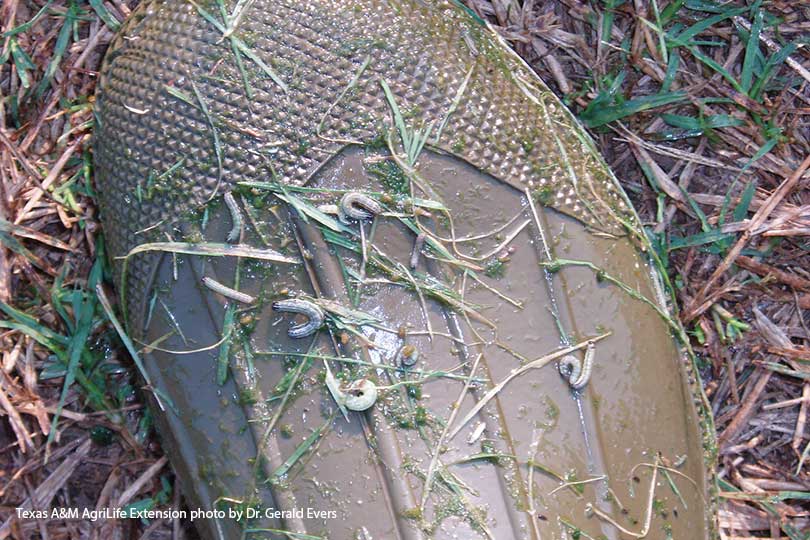By Shala Watson
Multimedia Writer
Two tiny pests are causing damage to pastures and hayfields in East Texas and other regions of the state this summer.
Intermittent rainfall followed by dry periods have created ideal conditions for large populations of fall armyworms and Bermudagrass stem maggots, according to Dr. Vanessa Olson, Texas A&M AgriLife Extension forage specialist.
These two pests can cause yield losses and reduce supply and quality of hay if left untreated.
Olson said most reports of substantial damage from fall armyworms are in East Texas where heavy rain has fallen.
“Moisture really promotes the populations and supports the environment that they prefer to forage in,” Olson told the Texas Farm Bureau Radio Network.
The fall armyworm larva grows up to 1.5 to 2 inches in length, Olson said. As the larvae develop, they consume more forage.
In the last two to three days of their larva stage, they consume 83 percent of their total diet.
“[Fall armyworms] prefer high-quality forage or well-fertilized forage over forage that has not been taken care of or managed very well,” Olson said.
They are night feeders and prefer to forage during cooler temperatures. Given their immense appetite, large populations and marching ability, armyworms can destroy a hayfield overnight.
She noted the threshold for insecticide spray treating a pasture is three or more armyworms per square foot.
The fall armyworm does not overwinter in North Texas, but survives the winter in South Texas, according to Texas A&M AgriLife Extension Entomologist Allen Knutson. The populations increase in South Texas in early spring and move north as the season progresses.
During periods of dry weather followed by rainfall, Olson advises farmers to scout their pastures.
The Bermudagrass stem maggot, is also causing damage in East and Central Texas. She said the pest only infests Bermudagrass and stargrass.
The adult fly lays its eggs on the Bermudagrass and the stem maggots hatch from the egg, according to Olson. They burrow into the stem and move to the highest point within the stem.
“They consume the plant material in that stem, killing the top two to three leaves,” Olson said.
She noted the maggots can also give the appearance that the field has suffered from frost damage or pesticide or herbicide burn damage. But further investigation will reveal the damage is a result of the maggot.
Pyrethyroids and insecticides used to control armyworms or fly populations have not been effective to kill and control the Bermudagrass stem maggot populations, Olson said.
Research has shown the stem maggot will overwinter in various parts of Texas. Olson noted if ranchers have had maggots in the past, it is likely they will return.
“We’ve seen in the past several years, the stem maggot will overwinter in various parts of Texas,” Olson said. “So no one is necessarily immune unless you don’t have any Bermuda grass.”
Once the maggot has been detected, Olson recommends harvesting as soon as possible to reduce the potential yield loss for that next cutting.
She said yield losses may differ in pastures used for grazing than in hay meadows, because cattle remove the top part of the plant where the maggot is burrowed.
For more information and additional publications on various forage topics such as armyworms and hay production, visit foragefax.tamu.edu.
Click here to hear more from Olson’s interview.

